Used fluorescent lamps. Repair and basic malfunctions of fluorescent lamps. Lamp characteristics: power, size, temperature and fluorescent light.
If you decide to save on room lighting, then economical light bulbs just for you. They can be used both at home and in offices. The lamp is especially popular daylight. It has quite a lot of advantages.
Advantages of the device
First of all, the following should be noted:
Fluorescent ceiling lamps also offer cost-effective benefits. Fluorescent ceiling lights typically use less electricity than other lights that produce the same number of lumens. Obviously, less electricity used means a lower overall electricity bill.
Connecting round and long lds on pins without a starter
Incandescent lamp. For years, the incandescent light bulb has been making its home in the recessed mount ceiling light and it doesn't seem to be budging. While the incandescent light bulb highlights that familiar, age-old warm light They consume a lot of energy for the amount of light that is produced. Perhaps the biggest tangible benefit to incandescent bulbs, other than its warm color temperature, is its dimmability.
Reduced energy consumption;
Bright rays that help make the room very bright;
Long service life;
A modern fluorescent lamp does not flicker;
The product is fireproof;
The device can be installed on a wall, table or hung on the ceiling;
Variety of shades.
When it comes to ceiling lights, your intended use will determine the type of light you want. For example, in a commercial setting you see a lot industrial lighting walkways, recessed lighting and backlighting. In galleries, studios and retail stores you see a lot of halogen bulbs because halogen colors look great.
In living spaces, you see track lighting and recessed lighting, of course, but you also see a lot of recessed cans, downlights, and semi-pendant lights, as well. pendant lamps, such as chandeliers. Commercial spaces are often larger, so you'll see larger lamps, and recessed lights up to 2 inches in diameter are more common in household premises. The shape and function of your space will always determine the type of ceiling lights you want.
In addition, you can choose a lamp of any shape. However, we should not forget about the disadvantages of such lamps.
Flaws
Let's list the main ones:
Poor quality products can burn out quickly;
A starter is required to start the lamp;
At low air temperatures, such a lamp operates quite dimly;
When such a lamp is turned on, the eyes may react painfully to the bright beam.
Ceiling lights for hidden installation and translucent ceiling lights. Pendant ceiling lights are lights that are mounted on the ceiling. Round flush mount fixtures - in traditional incandescent or fluorescent lighting - are a standard ceiling mount fixture. Lamps with translucent mounts are also popular. Lamps with a translucent mount usually extend a few centimeters from the ceiling on a rigid arm and are sometimes a little more decorative in nature.
Recessed Lighting Recessed lighting is the ruler of the kingdom of ceiling lights. Road lighting is excellent lamp for ceiling lighting. You might be surprised at how roadway lighting has evolved over the years, moving from a primarily utilitarian type of ceiling light to a star player in modern design lighting. Track lighting is also a versatile light source, great for backlighting and hanging pendants.
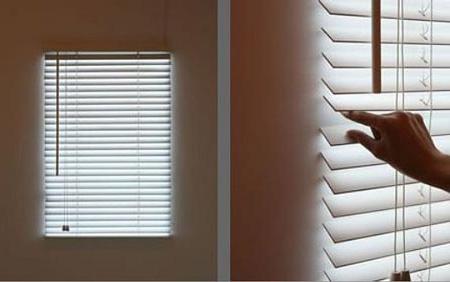 It is advisable that the presented lamp be covered with a shade. This will help eliminate the last drawback.
It is advisable that the presented lamp be covered with a shade. This will help eliminate the last drawback.
Peculiarities
The lamp can have different power (from 25 to 100 Watt). For everyday household use it is optional. However, if you work with documents at home, like to do handicrafts, or simply have an under-represented lamp, this lamp will be indispensable.
Color rendering and color temperature markings
Cove Lighting Some people neglect to think about cove lighting when they think about ceiling lighting. Recessed cans and flush mount fixtures are special features such as islands. So the lighting in the bays is a bit of a mystery. This creates the softest ambient lighting, similar to a simple glow, e.g. small corner which you cannot see, there is a little light. Cove lighting adds an element of mystery and surprises any space. It creates a smart, modern and relaxed mood, which is why you'll see it everywhere from spas to corporate offices.
It should be noted that ceiling fluorescent lamps, the price of which is $10 or more, are very often used in office, medical, and industrial institutions. They are also extremely effective in small, windowless spaces (closets). The presented products are also installed in those rooms where there is very little natural light.
Fiber Optic Ceiling Lights Looking for a really cool ceiling lighting option? Fiber Optic ceiling lighting literally impressive. This creates a spectacle on the ceiling. Is there an even greater gift to give to a child? When fiber optic ceiling lights are the only source of light at night, the little girl or guy will have something that looks pristine and, yes, magical. While other neat things fade and gather dust and need to be put away, the starlit ceiling remains clear and amazing.
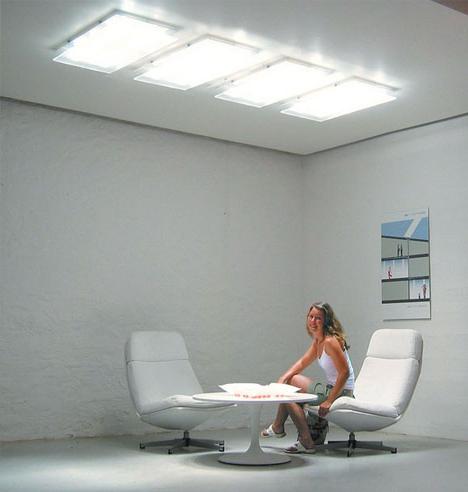 The presented lamps are considered cheap, but very effective. It should be noted that such lamps contain a minimal amount of mercury, so after use they cannot simply be thrown into the trash.
The presented lamps are considered cheap, but very effective. It should be noted that such lamps contain a minimal amount of mercury, so after use they cannot simply be thrown into the trash.
The fluorescent lamp fits perfectly into the interior, wherever it is placed. In addition, it can favorably emphasize the advantages of the room. It must also be said that modern models lamps have been significantly modified and do not have those significant shortcomings that the products are “from the past.” Dignity fluorescent lamps is that you can connect them yourself. You don't need special tools for this.
LED spot lighting
From a child's perspective, bedtime can become a little more attractive with the addition of fiber optic ceiling lights. We invite you to explore the products in this category and experience what is possible with latest technologies lighting.
Lamps in room design
In financial and environmentally They are really hard to beat. This makes them somewhat safer, especially if you have to handle them. In the past, traditional lamps only had a value expressed in watts. This is actually a power consumption metric that was used in the past to roughly indicate the brightness level. Their brightness is expressed in terms of "lumens". This is purely an indicator of the brightness of the light.
Very interesting option are wall fluorescent lamps. They are very effective and can decorate the interior. For example, lamps may have blinds installed on them. If you hang such a structure on the wall, the room will create the appearance of having a window. Naturally, you can simply attach several lamps enclosed in a plastic translucent housing.
We have a huge variety of designs, each with distinctive visual characteristics. They cannot be consciously noticed, but they are appearance will subtly contribute to the perception of your home or business premises. Let's start with the fact that the lamp heads have different shapes and sizes. The range includes spotlights on one or more bars, strip lights laid in abstract designs, ring lamp heads and many other shapes. The number of lamp heads built into each product varies greatly - from a single zone of light to a glamorous constellation.
Whatever option you choose, the presented lamps will serve you effectively for a long time. Therefore, the popularity of such lamps in the world is growing every day.
Fluorescent lamps are popular because of their efficiency and performance. Therefore, it is important for the home owner to know the characteristics of these devices, temperature, light, and connection features. Knowing the size and rules for replacing a broken light bulb will help you in interior design.
We even have products that can give you a continuous area of illumination. There is something for every environment and taste: sophisticated or simple, glamorous or utilitarian, ultra-modern or antique, curvy or angular, natural or industrial.
Modern daylight elements
All you have to do is configure the settings using the product controls. In the case of products that include spotlights, you obviously have the ability to adjust the position of each lamp head. It can be extremely in a useful way create impressive lighting effects. For example, in the kitchen you can use one spotlight to pull out hob. Another may be trained in work surface, where you cook food, and a third can highlight attractive feature, such as a group of display elements.
Ceiling fluorescent fluorescent lamps
Lamp characteristics: power, size, temperature and fluorescent light
Ceiling fluorescent fluorescent lamps differ in size from their wall-mounted counterparts. They also cover a large lighting area, so they are well suited for large rooms. They can often be seen in offices and shops. If your manor house spacious, you can equip it with ceiling fluorescent lamps.
Whether you are looking for ceiling lights for residential or commercial spaces, in intimate spaces or public place, you're sure to find a product to create just the effect you want. We even have a selection of products for children's bedrooms and playrooms. You can't help but smile when you see their fun and colorful designs.
Change your lighting settings from the comfort of your chair
In other words, those smart features that make life a little easier or open up aesthetic possibilities you'd never considered before. Do you want to know more? Browse our range and you will find many products that enjoy remote control. This will allow you to not only turn the lighting on and off, but also change its settings from the comfort of your chair. This way you can comfortably adjust your lighting while enjoying the evening with a book and a refreshing drink on the sofa.
Installation of ceiling fluorescent fluorescent lamps; photo
Ceiling fluorescent fluorescent lamps consist of:
- Glass tubes of different diameters and lengths, as well as shapes. on her inner surface located thin layer phosphorus - it transforms ultraviolet light.
- Electrical components: a cathode device (current will flow through its wires), which has two wires and pins, threads inserted into a support.
- A cap that fits over the end of a tube. It is firmly fixed and sealed to prevent gas leakage.
- Ballast resistor. This is a transformer whose task is to increase the voltage at the moment the lamp starts from 120 to 300 volts. The voltage value is then set to the required indicator thanks to the ballast resistor.
Tube interior fluorescent lamp comprises:
The use of fluorescent lamps in residential premises
Depending on the capabilities of a particular product, available settings may include reducing the overall light level and adjusting the color and quality of light. For example, a restaurant may require warm and festive lighting in the evening, but the cleaning staff may prefer near daylight lighting in the morning.
This number indicates the degree of protection against dirt and other foreign substances, including water. This is mainly a safety issue: only lamps designed for this purpose should be used in environments exposed to humidity. The light will come when it senses someone is in the room and leaves after a certain period of time without moving. You decide how long they will glow. This has positive benefits for energy efficiency and convenience. You might consider this type of product for warehouse environments where visitors will often have their hands on them and may not be able to handle light switches.
- A layer of phosphor, an inorganic substance.
- Internal space filled with mercury vapor.
- Two tungsten cathodes.

Ultraviolet radiation from mercury vapor occurs due to the glow of the phosphor layer deposited on the inside of the tube.
It's ingenious features like these that install our lighting apart from the crowd. You will also have the satisfaction of knowing that you are personally contributing to a cleaner, healthier planet. And with so many inspiring designs on the site, many of which have built-in adjustment features, you can't help but find a product to suit your needs.
Causes of problems with fluorescent lamps
In an ideal world, we'd all live and work in places that offered the perfect natural light for everything we needed to do, when we needed to do it. However, we don't all have the luxury of sitting next to windows on the wall, or simply the luxury of working in daylight only. And let's face it, the British weather usually leaves a lot to be desired. This is where fluorescent lamps can help, as they provide a similar level of illumination to natural daylight.
The operating principle of a ceiling fluorescent lamp consists of two stages: start-up and actual operation. To power the lamp, the following devices are needed:
- Starter.
- Throttle.
- Inductor coil.
- A capacitor designed to increase the phi cone (φ). The switching circuit represents a reactive load. The voltage is spent to magnetize the inductor, so a capacitor is included in the circuit. Energy is exchanged between the inductor and the capacitor, which increases the phi cone.
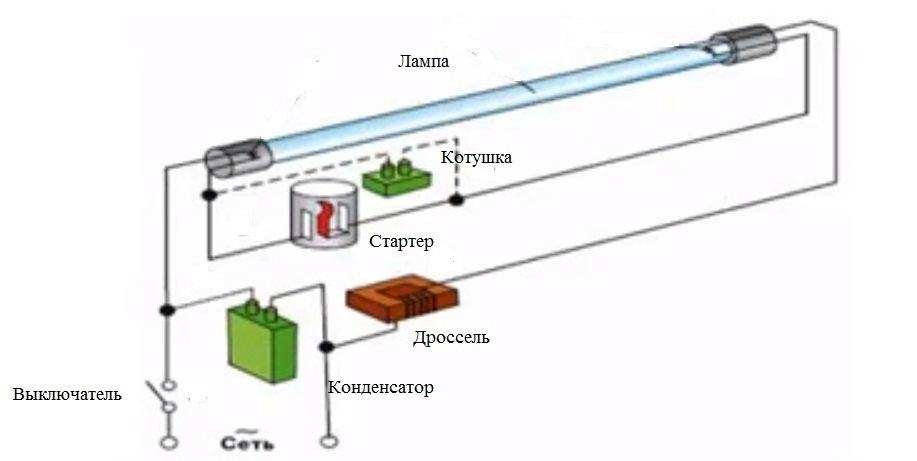
Different people need different things from lighting, especially in an office or learning environment. Workers working on the basis visual design, such as designers, architects, stylists and illustrators, require lighting as close to natural light, and anyone who handles a lot of paperwork or small print needs bright, clear lighting. It is interesting to note that in the sector retail Various types lights are used in ways you might not expect - supermarkets use special fluorescent tubes in their meat refrigerators to bring out the red color of the meat and make it taste good.
Lamp trigger mechanism
After turning on the switch, the current flows through the circuit: “throttle” - “lamp electrode” - “starter”. A glow discharge occurs between the starter electrodes. The current flows into the other electrode and back into the power circuit. When a voltage of 220 W reaches the electrodes of the lamp. In the starter, under the influence of a glow discharge, the bimetallic electrode begins to heat up - it closes with the stationary electrode. Since there is no glow discharge, the current in the lamp circuit increases and intensively heats the lamp electrodes.
Another important factor Something to keep in mind is that some people suffer from seasonal affective disorder, and even those who may not be affected by a lack of natural light in the long term. This doesn't just apply during the long, dark winter months, but is also a factor in offices where there is little or no natural light. Luckily, all of these things can be solved with full spectrum or fluorescent lights.
Daytime lamps or full spectrum, what's the difference?
In fact, there are differences between full spectrum and fluorescent lamps, so it is important that right choice fit your needs since not every lamp fills every role. The light emitted by a lamp is described by two dimensions, the first of which, color temperature, measured in Kelvin, is also used to measure the brightness of distant stars. The second measurement is the color rendering index, which measures the ability of a light source to accurately display colors and is displayed as a percentage.
Next, the bimetallic electrode in the starter cools down, since the glow discharge has disappeared. Due to cooling, the electrode returns to the opposite position. Thus, the two electrodes in the starter open. The circuit is disconnected - due to induction, a surge of voltage occurs on the inductor, which is necessary to ignite the arc. A high-voltage pulse appears between the two electrodes of the lamp. A glow discharge occurs in the lamp.
An important element for turning on a fluorescent lamp is the capacitor located in the starter. It increases the duration of the pulse to ignite the lamp. Otherwise, the pulse would be too short and the amplitude too large. The energy accumulated in the throttle during the opening of the two electrodes would be spent on the discharge in the starter. Thus, the lamp would not be able to light.
While the mercury inside the lamp has not completely evaporated, argon gas provides the glow. When the mercury is fully activated, the fluorescent lamp goes into operating mode. The lamp voltage becomes lower than the mains voltage due to its drop across the inductor. The starter does not fire again. It may start several times during the switching process if the electrodes in the lamp are not warm enough.
Connecting round and long lds on pins without a starter
Fluorescent lamps can work without a starter if they burn out, for example, and you want to give them a second life. In this case, the lamps will last longer, but not forever. When the starter is removed from the circuit, a so-called “cold start” of the lamp will occur. This means that it is ignited by increased voltage, and the electrodes are not pre-ignited.
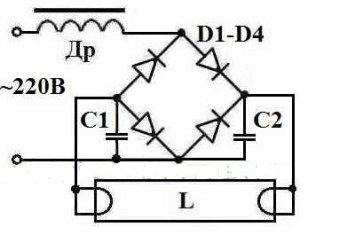
The disadvantage of operating a lamp without a starter will be that over time, the phenomenon of electrophoresis will occur - the glow will shift to one end, because without a starter, the lamp is powered using rectified current. To eliminate electrophoresis, change the polarity of the lamp connection twice or once a month. To do this, turn it over or install a switch.
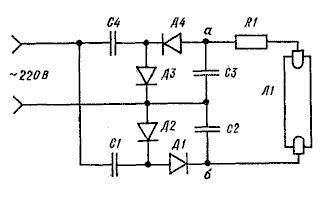
Lighting a lamp without a starter can be done in cases where it is not possible to quickly replace an outdated starter with a new one or with an electronic ballast. In the starterless connection option, the filaments serve as electrodes - they are supplied with voltage, which ignites the gas in the fluorescent lamp. A starterless connection allows the use of fluorescent lamps in which the filament has burned out.
You should take 4 capacitors, two of which should be made of paper and have a voltage one and a half times greater than in the network. The remaining two capacitors may be mica. The wirewound resistor must match the power of the fluorescent lamp. These values can be found in the table. 
Capacitors 1 and 4, diodes 2 and 3 make up a two-half-cycle rectifier that doubles the voltage. The larger the value of capacitors 1 and 4, the greater the voltage at the lamp electrodes will be. When it turns on, the voltage increases to 600 V, and at the moment of ignition the lamp works normally, since the voltage decreases and reaches the normal value of 220 V. Diodes 1 and 4 and capacitors 2 and 3 serve to reliably ignite the lamp - they increase the voltage to 900 V. The capacitors provide reliable ignition when the lamp is turned on and suppress radio interference.
Connection with electronic ballasts
Instead of an electromagnetic ballast, which is otherwise called a “throttle,” an electronic ballast can be used. The main advantage of this device is the absence of a starter, which is unreliable.

On in this example the device has 4 contacts, a pair per filament, the letter indicates phase, means zero. The device has one common wire and two separate.
Therefore, to replace the starter with electronic ballasts, you should:
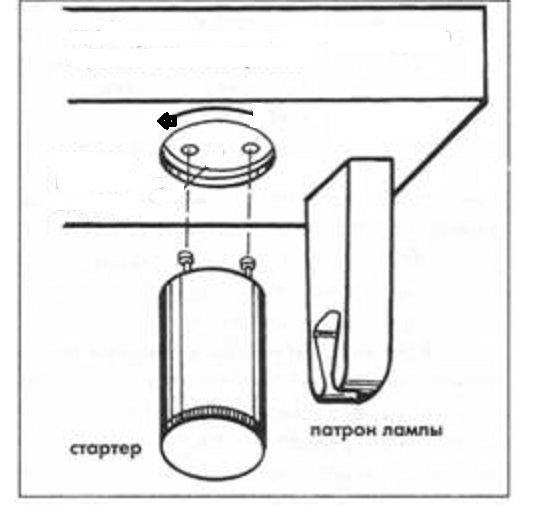
Rules for removing and replacing a broken light bulb
Unlike the familiar incandescent light bulb, removing a fluorescent lamp requires preparation, especially if it is linear and mounted on the ceiling. Height and length constitute difficulties.
Rules for removing a fluorescent fluorescent lamp:
- Turn off the power to the lamp. Don’t just press the switch, but turn off the room where it is located from the network at the electrical panel. Use a tester to check if there is voltage.
- Place a bench above the lamp if the lamp is on the ceiling, and securely place it under the lamp.
- Gently grasp the lamp by both ends with your hands. Rotate the tube 90 degrees until it stops. The clips will release the lamp so that you can carefully lower it and place it in a safe place where it will not be broken.
The rules for replacing a fluorescent ceiling fluorescent lamp are as follows:
- Make sure that the plugs of the lamp you are going to install are placed perpendicular to the sockets. To insert, rotate the lamp until it clicks 90 degrees. Pull the tube towards you a little to make sure it is fastened correctly.
- Turn on the light on the electrical panel. Normally operating lamps will fully light approximately one minute after power is applied.
If the lamp is in the lamp (which happens most often), the rules for removing and replacing are the same. The only advice is to hold the light diffuser and unscrew it from the mount; then insert into place, screwing securely.




